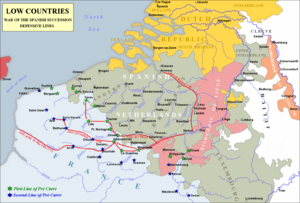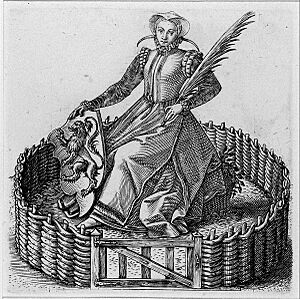Frontière de fer facts for kids
The Iron Frontier (or Frontière de fer in French) was a clever system of forts built by King Louis XIV in the late 1600s. After a peace treaty in 1678, he wanted to protect northern France from invaders. These forts also served as bases for French armies during wars like the Nine Years' War and the War of the Spanish Succession.
This defense system later grew into something even bigger called the Ceinture de fer, or "Iron Belt." This belt protected France's eastern and southern borders too. Sometimes, the Iron Frontier is also called the Pré carré, which means "square field" or "protected area." This name came from a famous military engineer.
Contents
Vauban's Big Idea: The "Pré Carré"
The idea of the Pré carré was first mentioned by Sébastien Le Prestre de Vauban. He was a brilliant French military engineer. In a letter from 1643, Vauban told the war minister that the king should make his "square field." He meant that France's borders were messy, with friendly and enemy forts mixed up.
Vauban believed this was expensive and made France weaker. He wanted a clear, strong border. He suggested that France should either gain or destroy certain forts to make its territory neat and secure. This idea became the main plan for building the Iron Frontier.
Vauban might have been inspired by the "Old-Dutch system of fortresses." This was a similar defense system in the Dutch Republic. It had many layers of forts that helped stop a French attack in 1672.
Designing the Defenses
Vauban imagined a defense system with different layers, like a team in a game. He advised which enemy forts to capture and keep. He also suggested which ones to avoid or even tear down. His goal was to create strong barriers that would protect France's land.
He didn't just want to build more and more forts. Vauban wanted to make France's borders smarter. He often talked about getting rid of old, useless forts and building new, better ones.
The name "Iron Frontier" was actually given later by Lazare Carnot. Officially, the system was called the "regulation for the border places." While Vauban came up with the main idea, others, like the war minister and even the king, helped decide the final shape of the system over many years.
Vauban designed many of the forts in the system. He believed in adapting each fort's design to the local land. He used natural features like rivers and hills to make the forts stronger. As the main person in charge of fortifications, he oversaw the building of the system from 1677 until he died in 1707. He didn't see the system completely finished, but it was briefly completed after his death.
Where the Forts Were Built
The Iron Frontier stretched from the sea at Dunkirk all the way to Dinant. This area was quite open, making it easy for armies to move around. This was different from the land to the east, which had natural barriers like mountains. So, France needed to build a strong man-made defense here.
Vauban wanted to create a strong center in this open plain. From this center, the French army could stop invaders head-on. They could also attack the enemy's sides if they tried to go around the forts. He used natural obstacles like rivers and canals. He even used planned flooding to make the defenses stronger.
The system had a "first" or "northern" line of forts. These included Mons, Condé, and Tournai, with Ath in front. Behind this first line was a second line. This included forts like Douai, Arras, Valenciennes, Bouchain, Cambrai, Maubeuge, Landrecies, and Le Quesnoy. To the east, there were forts such as Namur, Charleroi, Philippeville, Mariembourg, Avesnes, Rocroi, and Charlemont. On the western side, you would find Nieuwpoort, Knokke, Ypres, and Menen.

The Forts in Wartime
The Iron Frontier was built during a time of war. Because of this, the forts often changed hands between different countries. By 1701, when the War of the Spanish Succession began, France controlled all of them. But during the war, France lost many of these forts to its enemies.
After the Peace of Utrecht treaty, some of these forts were no longer part of France's control. Interestingly, some of them became part of a "Barrier" system. This Barrier was created to protect the Dutch Republic from future French attacks after 1715. So, forts like Knokke, Ypres, Menen, Tournai, Mons, and Namur ended up protecting France's enemies instead!
Sources


